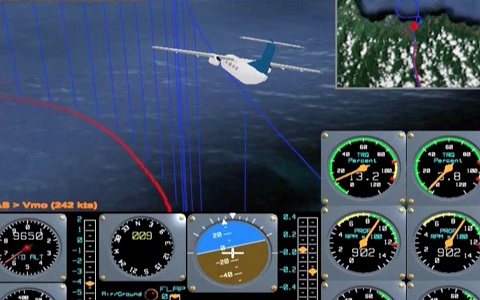A special report by Fabian Hakalits reveals how the ill-fated Airlines PNG Dash-8 aircraft crashed in Madang.
Twenty-eight passengers lost their lives in what was described as Papua New Guinea’s worse aviation disaster.
The crash investigation is shown in animation, produced by the Papua New Guinea Air Investigations Commission.
It was on that black Thursday afternoon, October 13 2011, when the Airlines PNG Bombardier DHC-8-103, registered P2-MCJ, crashed landed in Madang.
The aircraft was conducting a regular public transport flight from Port Moresby to Madang via Lae. On board were three flight crew, the captain, first officer, flight attendant and twenty-nine passengers.
After a 32-month wait, the Papua New Guinea Accidents Investigation Commission finally released an aircraft incident report.
The narration in the video was based on information sourced from the black box retrieved by investigators.
The autopilot could not be used because the yaw damper was un-serviceable, and so the aircraft had to be hand-flown by pilots.
At Nadzab, Mike Charlie Juliet refueled and departed, with the pilot in command as the handling pilot.
Once in air, the flight diverted completely off the planned track to avoid thunderstorms and clouds.
The captain reported that communications between Madang tower and an aircraft in the vicinity indicated to descend below the clouds and was looking mainly outside the cockpit.
Due to the storm, there were some urgency to descend beneath the clouds, based to position for a right base for run way 07 at Madang.
MCJ: Madang tower, Mike Charlie Juliet, two, four DME, passing thirteen thousand on descent estimating Madang one, six, negative ATIS.
MADANG TOWER: Mike Charlie Juliet, Madang tower, say again your level.
MCJ: Passing, twelve thousand, three hundred this time at, two three DME, Mike Charlie Juliet.
On this route, the descent to Madang was steep because of the need to remain above the Finisterre Ranges.
Although the aircraft was descending steeply, propellers were at their cruise setting of 900 revolutions per minute.
Neither pilots noticed the airspeed increasing towards maximum operating speed, the pilot in command reported afterwards, distracted by the weather.
MADANG TOWER: Mike Charlie Juliet, roger runway zero, seven, wind is bearing between the east and north easterly, at five knots maximum, one zero QNH, one zero, zero, nine, rain, showers currently overhead and (positing) to the west from the east, visibility, reducing to one thousand meters; are, report five DME.
MCJ: … (…Indistinct conversation…) report five DME. Mike Charlie Juliet.
The angle of the propeller blades changed from forward to ‘beta’ or ‘reverse range’ and the tremendous speed subsequently drove the engines’ turbines over the maximum permitted revolutions per minute. It damaged the left hand engine seriously, stopping the right one as well.
This caused a big bang, a noise that was also heard by villagers.
The emergency caught both pilots by surprise, confusion and shock on the flight deck.
On the captain’s order, the first officer made a mayday call to Madang tower, and gave the GPS position, maintaining a lengthy radio exchange with Madang tower for 63 seconds.
MCJ: Madang tower, mayday, mayday, mayday, Mike Charlie Juliet, double engine failure and we’re making an emergency landing.
MADANG TOWER: Mike Charlie Juliet, confirm you are able to make it to the field.
The flight crew did not conduct emergency checklists and procedures but instead, their attention turned to where a forced landing was to be made.
The aircraft descended at a high rate, with the wind-milling left propeller causing extra drag.
The asymmetry between the wind-milling left propeller and the feathered right propeller made the aircraft difficult to control.
The average rate of descent between the onset of the emergency and arrival at the crash-site was 2, 500 feet per minute, at one point exceeding 6, 000 feet per minute.
The first officer said the aircraft should be ditched; after a brief discussion, however, the captain decided to make a forced landing in the mouth of the Guabe River.
Approximately 800 feet above sea level and 72 seconds before the impact, both engines shut down.
MCJ: Negative, negative, negative, we’ll probably be ditching.
MADANG TOWER: Roger, confirm along the coastline.
MCJ: Affirm, affirm, Mike Charlie Juliet
MADANG TOWER: Roger the approximate coordinates of your ditching.
MCJ: We are currently at fourteen miles to the east of you at this stage.
MADANG TOWER: Roger, could you give us the approximate coordinate.
The captain decided to land beside the river but was not readily visible from the air. The plane crashed-landed on the impacted terrain at 114 knots with flaps and the landing gear retracted.
The tail was impacted first, consumed by a fuel-fed fire.
https://youtube.com/watch?v=r-2ppu6NX68%3Ffeature%3Doembed%26wmode%3Dopaque%26showinfo%3D0%26showsearch%3D0%26rel%3D0
previous post


